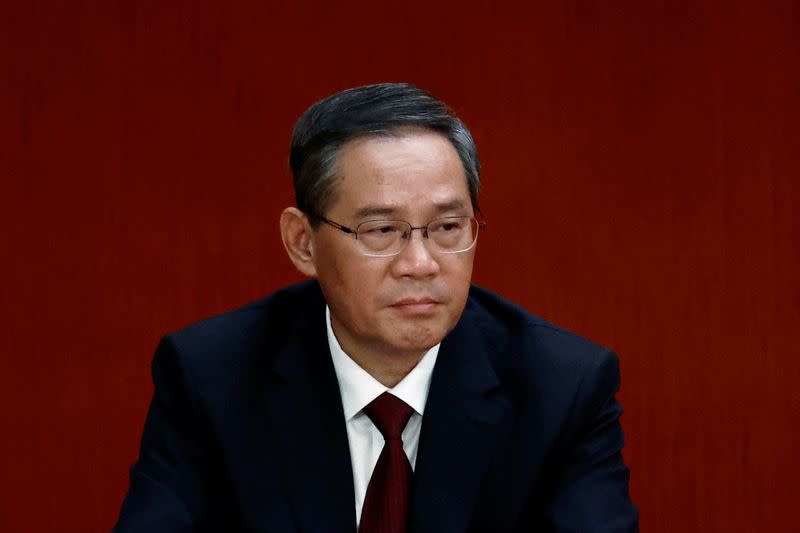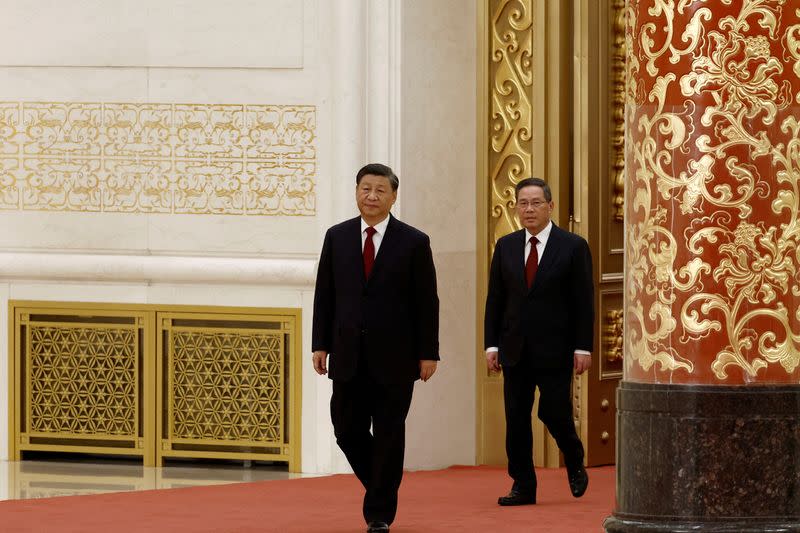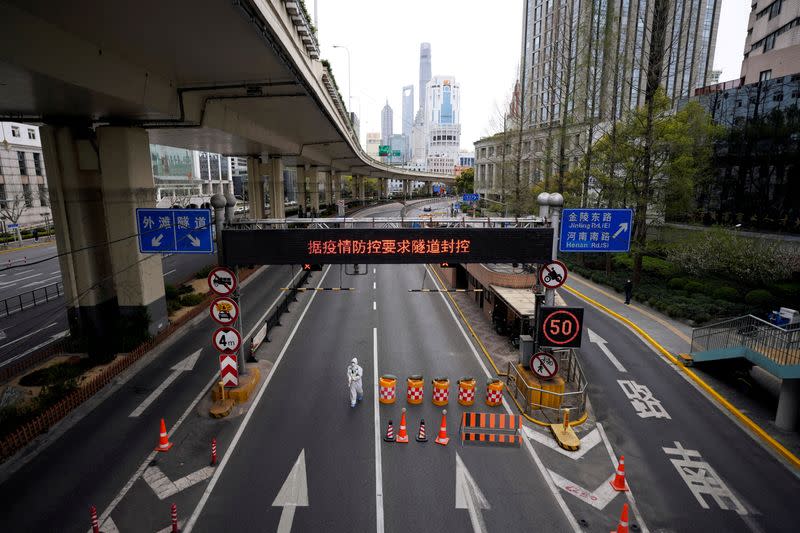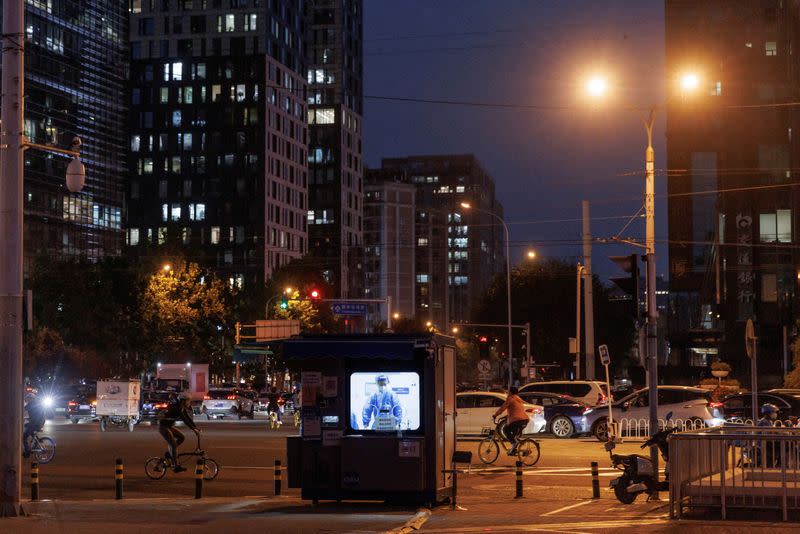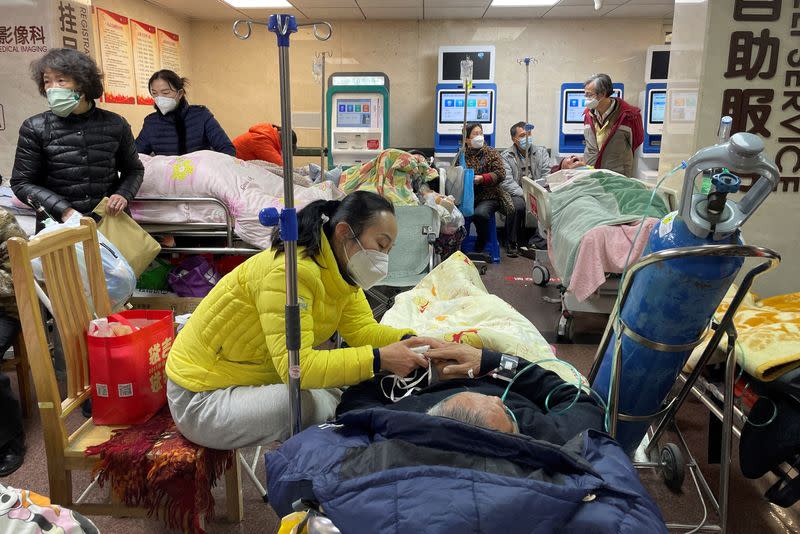How China's new No.2 hastened the end of Xi's zero-COVID policy
By Julie Zhu, Yew Lun Tian and Engen Tham
HONG KONG/BEIJING/SHANGHAI (Reuters) - As unprecedented protests against China's zero-COVID policies escalated in November, Li Qiang, the man recently elevated to No.2 on the ruling Communist Party's Politburo Standing Committee, seized the moment.
Top Chinese officials and medical experts had been quietly formulating plans over the preceding weeks to dismantle President Xi Jinping's zero-COVID strategy and gradually reopen the country towards the end of 2022, with the aim of declaring a return to normality in March, four people with knowledge of the matter told Reuters.
Li, who is set to be named the country's new premier this month, took a more urgent view.
He abruptly drove a decision to activate the reopening plans sooner than intended, in an effort to contain the economic toll of the zero-COVID campaign and protests that had rattled the leadership, said the four people and another person with knowledge of the matter. The upshot was a chaotic reopening in December, when China suddenly ended lockdowns, mass testing and other restrictions.
Beijing has not publicly explained its decision-making process behind its U-turn on the zero-COVID approach. Xi and Li, as well as the State Council, China's cabinet, did not respond to requests for comment from Reuters submitted via the State Council Information Office (SCIO) about the discussions regarding reopening the country.
Reuters assembled this account of China's path to reopening after speaking to more than half a dozen people with knowledge of the discussions. The previously unreported details offer a rare window into deliberations among top Chinese officials and healthcare experts, including differences between Li and Xi about the pace of reopening. The people spoke on the condition of anonymity because of the subject's sensitivity or because they weren't authorised to talk to the media.
The protests in November marked a turning point in Xi's handling of COVID management as he started to take a less hands-on approach and allowed Li, his long-time ally, to take charge, two of the people said.
Top leaders ultimately opted for a hurried reopening that would pacify the young protesters because the threat the dissenters could pose to the regime's stability was seen as more politically risky than allowing the virus to spread unchecked, two of the sources said.
PREPARING SCENARIOS
At a Communist Party congress in mid-October where he secured a precedent-breaking third term and unveiled his new leadership team, Xi had extolled his zero-COVID policy, saying it was achieving positive results. Yet, before the month was out, officials gathered in Beijing to consider how to unwind that strict approach.
Wang Huning, deputy head of the party's central COVID taskforce since early 2020 and a member of China's elite seven-man Politburo Standing Committee, held a closed-door meeting in late October with top medical experts and senior officials, including those from the propaganda apparatus, according to three of the sources.
Wang repeatedly asked the attendees how many deaths an abandonment of COVID controls would cause in a worst-case scenario, and pressed them to work on various reopening roadmaps with differing paces, two of the people said. Wang did not respond to a request for comment submitted via the SCIO about his role in the talks.
Officials from the National Health Commission (NHC) proposed benchmarks for full reopening, the key being improving the elderly vaccination rate, said two of the sources.
Meanwhile, some local-level party workers and healthcare officials were grappling with growing challenges in implementing the zero-COVID policy.
A local leader of a sub-district in Beijing with over 100,000 residents told Reuters that by the second half of last year it had run out of money to pay testing companies and security firms to enforce restrictions.
"From my perspective, it's not that we set out to relax the zero-COVID policy, it's more that we at the local level were simply not able to enforce the zero-COVID policy anymore," the official said.
Beijing's local government, which did not respond to a request for comment, spent nearly 30 billion yuan ($4.35 billion) on COVID prevention and controls last year, official data show.
Party leaders are expected to present plans to help the economy recover from pandemic curbs at China's annual meeting of parliament starting March 5.
NUMBER CRUNCHING
As officials worked on reopening plans, the virus was already outpacing the government's ability to contain it.
An official at the Chinese Center for Disease Control and Prevention (CDC) in one of the country's largest cities said that as infections soared in the autumn, staff tasked with collating infection data would regularly ask senior CDC managers if the number they were seeing was "too high", and whether they should report a lower figure to the public. Doing so could make it seem the outbreak was under control, the person said.
"At that point, I was cutting up to 50%," said the official, adding that local authorities were running out of money and salaries for some CDC officials were cut last year.
The CDC did not respond to a request for comment about China's case data and its involvement in reopening talks.
In response to a Reuters request for comment, the NHC said China had continuously optimised and adjusted prevention and control measures with the aim of protecting health, and had transitioned smoothly to reopening in a relatively short time.
RISE OF LI
Talks about reopening coincided with Li's rise. Before his promotion in October, the 63-year-old was in charge of Shanghai, where he oversaw a harrowing two-month lockdown of the city's 25 million people last year.
After the congress, Li took charge of China's battle against the virus as head of the party's central COVID taskforce, which reports to the Politburo Standing Committee, according to two of the sources. On Nov. 11, China announced a modest set of 20 measures to loosen restrictions.
Xi himself had begun to take fewer personal precautions. He started to appear in public without a mask both in Beijing and overseas, as shown by his meeting with U.S. President Joe Biden on Nov. 14 before the Group of 20 summit in Indonesia, as well as a bare-faced confrontation of Canadian Prime Minister Justin Trudeau.
But when daily cases mounted after China's easing measures took effect, Xi wavered, and wanted to revert to the zero-COVID approach, said three people familiar with the matter. In mid-November, when Xi was still in Southeast Asia, he ordered Chinese authorities to "unswervingly" execute the zero-COVID policy, said two of the people, after which some cities retightened curbs.
Xi's vacillating led to renewed debate on COVID policy among top leaders during mid to late November, one of these people and another person said. By then, there were enough indications to suggest that economic growth was set to slump to one of its worst levels in nearly half a century.
In discussions after Xi returned from overseas on Nov. 19, Li resisted pressure from the president to slow the pace of reopening, two of the people said. Reuters was not able to establish how Xi reacted.
As the virus continued to spread, Li encouraged local party officials, including in Shijiazhuang, capital of Hebei province, to stick with the 20 easing measures, two of the sources added. In mid-November, Shijiazhuang halted routine community testing as it was reporting hundreds of new infections daily.
A Shijiazhuang government representative declined to comment on any engagement with Li or the effects of pandemic policies on residents.
TURNING POINT
Around this time, millions of people in China were tuning in to the soccer World Cup in Qatar, where footage of packed stadiums and maskless fans led Chinese social media users to complain about the stark contrast with their situation.
A final trigger for accelerating reopening came in late November. After a deadly fire in China's Xinjiang region, protests calling for an end to zero-COVID swelled into the biggest show of dissent in mainland China since Xi took power.
Xi blamed the protests on youth frustrated by the pandemic. But he said the Omicron variant, rather than more-lethal Delta, was now dominant in China, paving the way for fewer restrictions, senior European Union officials told Reuters after European Council President Charles Michel and other senior EU figures met Xi on Dec. 1.
Finally, on Dec. 7, China announced sweeping changes to its COVID policy, abruptly ending many curbs such as lockdowns, mass testing and local travel restrictions. Plans for the reopening initially would have maintained mass testing, but Li pushed successfully for a broader relaxation that eschewed it, two of the sources said.
Immediately following the reopening, the virus was unleashed, hospitals and crematoriums were overwhelmed and pharmacies stripped bare. Undeterred, Li urged officials during a nationwide teleconference on Dec. 25 to promptly deploy resources and secure medication and treatment for key groups, including the elderly and children.
Li told the officials that "the timing is right and the basic conditions are in place" to manage COVID as a less severe, Category B disease, per a written summary of the meeting reviewed by Reuters and confirmed as authentic by one of the sources.
On Feb. 16, Xi declared a "decisive victory" over COVID in a meeting with top leaders, according to Xinhua, describing the party's judgment and decisions, including the "major adjustments" to the pandemic strategy, as "completely correct", effective and well received by the public.
(Additional reporting by Beijing Newsroom. Editing by Sumeet Chatterjee and David Crawshaw.)

 Yahoo News
Yahoo News 